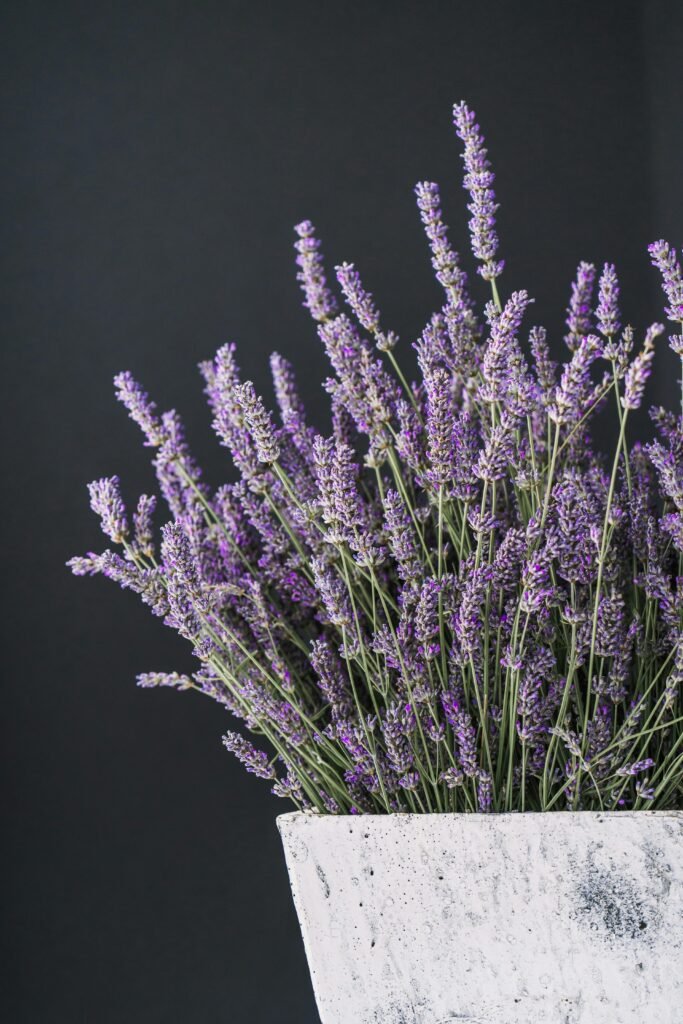2. Lavender
The Medicinal Value of Lavender:
Scientific Overview
Lavender (Lavandula angustifolia) is a flowering plant renowned for its aromatic fragrance and therapeutic properties. Native to the Mediterranean region, lavender has been utilized for centuries in various forms of traditional medicine. Modern science has validated many of these traditional uses, uncovering the biochemical mechanisms that underpin its medicinal value.
Scientific Explanation of Medicinal Value
Lavender’s therapeutic properties are primarily attributed to its essential oil, which contains a complex mixture of phytochemicals, including linalool, linalyl acetate, camphor, and terpinen-4-ol. These compounds exhibit a range of biological activities:
Anti-inflammatory Effects: Linalool and linalyl acetate are known to inhibit inflammatory responses by reducing the production of pro-inflammatory cytokines and enzymes, such as cyclooxygenase (COX-2). This action helps in alleviating pain and swelling.
Antioxidant Properties: Lavender oil exhibits significant antioxidant activity, neutralizing free radicals and preventing oxidative stress, which is implicated in various chronic diseases.
Antimicrobial Activity: The essential oil of lavender has demonstrated broad-spectrum antimicrobial effects against bacteria, fungi, and viruses. This is primarily due to the presence of camphor and other terpenoids that disrupt microbial cell membranes.
Anxiolytic and Sedative Effects: Linalool and linalyl acetate also interact with neurotransmitter systems in the brain, particularly the GABAergic system, which enhances the effects of the inhibitory neurotransmitter GABA. This leads to reduced anxiety and promotes relaxation and sleep.
Therapeutic Applications of Lavender
Lavender’s medicinal properties make it a versatile remedy for various ailments. Here are some specific conditions it can help with and detailed instructions on how to use it:
1. Anxiety and Stress
Usage:
- Aromatherapy: Add 5-10 drops of lavender essential oil to a diffuser and inhale the calming scent for 15-30 minutes. This method helps reduce anxiety and promotes a sense of calm.
- Topical Application: Mix 2-3 drops of lavender essential oil with a carrier oil (such as jojoba or almond oil) and apply to the temples and wrists. Gently massage to enhance relaxation.
2. Insomnia and Sleep Disorders
Usage:
- Aromatherapy: Diffuse lavender oil in the bedroom for 30 minutes before bedtime. Alternatively, sprinkle a few drops on a pillow or bedding.
- Bath Soak: Add 10-15 drops of lavender essential oil to a warm bath and soak for 20 minutes before bed. This promotes relaxation and improves sleep quality.
3. Skin Irritations and Wounds
Usage:
- Topical Application: Dilute lavender essential oil with a carrier oil in a 1:1 ratio and apply directly to minor burns, cuts, or insect bites. Lavender’s antimicrobial and anti-inflammatory properties facilitate healing and reduce pain.
- Creams and Ointments: Use commercial creams containing lavender oil or create a homemade salve by mixing lavender oil with shea butter and beeswax. Apply to affected areas twice daily.
4. Headaches and Migraines
Usage:
- Inhalation: Inhale lavender oil directly from the bottle or apply a few drops to a handkerchief and breathe deeply. This can help alleviate headache symptoms.
- Massage: Combine lavender oil with a carrier oil and massage into the neck, temples, and forehead to relieve tension headaches.
5. Digestive Issues
Usage:
- Herbal Tea: Prepare lavender tea by steeping 1-2 teaspoons of dried lavender flowers in boiling water for 10 minutes. Drink up to twice daily to soothe digestive discomfort, such as bloating and indigestion.
- Essential Oil: Dilute a drop of lavender essential oil in a tablespoon of honey or add to a cup of warm water and drink. This can help ease stomach cramps and nausea.
Lavender’s multifaceted medicinal properties, supported by scientific research, make it an invaluable addition to natural remedies. Its ability to alleviate anxiety, improve sleep, heal skin conditions, relieve headaches, and soothe digestive issues showcases its therapeutic versatility. By incorporating lavender into daily routines through aromatherapy, topical applications, and teas, individuals can harness the plant’s full potential to enhance their overall health and well-being.




